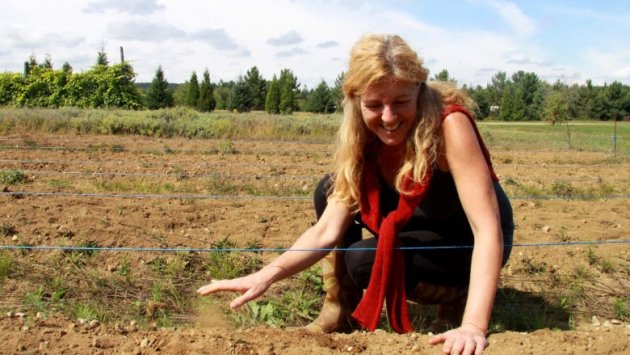
One cannot resist this story. Obviously this can grow into a major industry as they are now proving viability. Do note the unusual growing cycle as well. surely this can be folded together with other summer crops that do not bind up the soil making life difficult for the crocus.
In fact it makes an excellent garden crop which is also small enough to be handled. The bulbs can be broken up and replanted in the spring deep enough to avoid disturbance and then the beds can be used all summer to produce non root plants including radishes, onions, peas, tomatoes and squashes easily enough. Even corn will not disturb the bulbs provided they are deep enough and the root pad is removed at the end.
While hardly conducive to large acreage operations, it is tailor made for every serious gardener and it is certain that a regular market will spring up to absorb the actual output with an ounce of encouragement.
.
Canada's first saffron farm expecting excellent crop
Thu, 25 Sep, 2014
https://ca.news.yahoo.com/canadas-first-saffron-farm-expecting-100000785.html
Canada's first farm
dedicated to growing saffron, the spice that's worth more than its
weight in gold, is getting ready to harvest its first bumper crop.
But even that will weigh about the same as a pound of butter.
Pur Safran, located in the small Quebec village of St-Elie-de-Caxton,
expects to harvest 450 to 500 grams of the precious spice before the
end of October.
"We would like for Quebec to become self-sufficient in saffron
production, because we can do it," said Pur Safran
co-owner Nathalie Denault, who not only produces the spice, but teaches
other potential growers the ropes.
Saffron comes from the reddish-orange stigmas of a particular crocus
flower and is considered to be the most expensive spice in the world.
Denault and farm co-owner André Laplante travelled to France to learn
how to grow it and came back to Quebec to run a series of tests.
Once they were sure they could start production in Canada, they set out to find the perfect patch of land.
Of the 50,000 bulbs imported from France, only three didn't survive last winter's record-breaking cold temperatures.
Denault says the saffron flower can be burned by the cold, so needs a thick snow cover to thrive.
The flower's biological clock works opposite to that of most crops.
The bulbs sprout in the fall, bloom into a fragrant purple flower
which only lasts 24 to 48 hours, then reproduces by splitting into more
bulbs under the snow. The plant's dormant phase is in the summer.
Finding a 'magical' spot to grow
Denault and Laplante picked St-Elie-de-Caxton to build their farm not
only because the growing and soil condition were ideal, but also
because of the tourists.
In the past seven years, the town has developed a tourism industry
based on the fantastical stories of Quebecois storyteller Fred Pellerin.
"St-Elie is magical for so many different things, and we needed a
place where magic would work, and it is working," Denault said.
Pur Safran offers tasting, information about the spice as well as sells homemade products to tourists who stop by the farm.
Once the harvest is over, they'll also sell dried saffron. Last year's stock has already run out.
They only harvested about 75 grams last year, but Denault said that was expected.
"The bulbs went to sleep in France and woke up in Quebec," she said. "They needed to adapt."
Denault estimates there are 60 kilograms of international saffron
sold in Quebec each year, but it's difficult to get an accurate number.
Because of saffron's significant value, fraudsters alter the spice to
up the weight. The end result is often spice of much poorer quality.
Expanding the industry, one grower at a time
Pur Safran is also planting the idea of saffron in the heads of other farmers.
Last summer, they taught three other couples how to start their own farm, each graduating with 3,000 of their own bulbs.
Despite training what will be their own competition, Denault says she's not worried about business spreading thin.
"Every producer of saffron produces little quantities, so we will
never, ever, no matter how many producers we are, we'll never make
enough saffron for the demand."
No comments:
Post a Comment